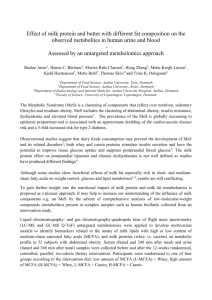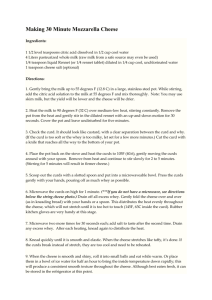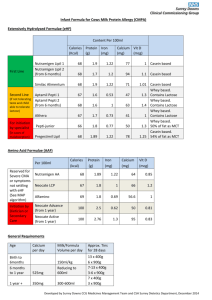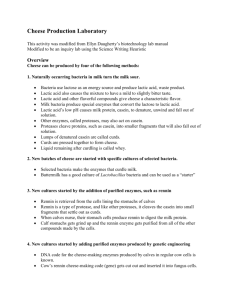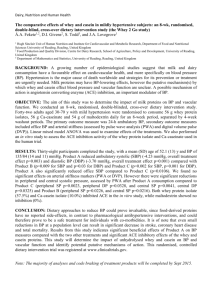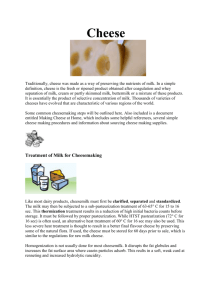Thesis - Conferences
advertisement
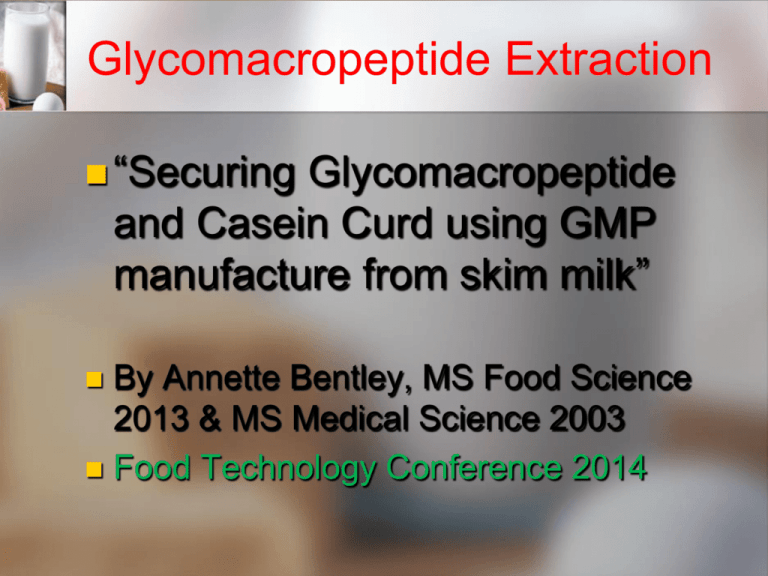
Glycomacropeptide Extraction “Securing Glycomacropeptide and Casein Curd using GMP manufacture from skim milk” By Annette Bentley, MS Food Science 2013 & MS Medical Science 2003 Food Technology Conference 2014 INTRODUCTION Milk Major component of milk consist of 86.6% water, 5% lactose, 4.6% fat, 3.6% protein, and 0.7% ash. Minor components are enzymes, vitamins, and minerals (Swaisgood, 2007). Milk proteins are classified as either casein proteins or whey proteins (Dauphas, 2008). Casein Casein consists of 80% of the proteins in milk Four main types: αs1-, αs2-, β- and k-caseins. Stability of the casein micelles attributed to negative charge & steric repulsion by the micropeptide region of k-casein flexibility. Ca-induced interaction between protein molecules, electrostatic, hydrophobic & hydrogen bonding are responsible for the micelle integrity (Lucey, 2004). Rennet General Application Rennet is a natural complex of enzymes in any mammalian stomach to digest mother’s milk. Proteolytic enzyme coagulate milk causing separation of curds & whey. The active enzyme is called chymosin or rennin. Rennet History Plant coagulation was used for fermenting cheese since agent times in Portugal. These plants can be found in southern European countries used for cheese making but some do not consider them of high quality. Calf rennet (rennin)was widely used until the 1970s (Esteves 2001). A growing demand for alternative source of coagulatents because of the reduced supply of calf rennet. Vegetarians have called for vegetarian alternative. Rennet Preparation The preparation of the lamb rennet (Irigoyen,2000) is collected and dried in a ventilated place protected from light. Once dried, the fat is removed from the external surface and cut into cubes. It is then mixed with salt and kept in darkness at 4oC. It is dissolved in water and filtered. It is then preserved in cold, dry and dark until used. Chymosin (Rennin) Chymosin is added in the manufacturing of cheese. Chymosin is a proteolytic enzyme synthesized by chief cells in the stomach. It is secreted as an inactive proenzyme called prochymosin. It is most active in acidic environments. It causes the coagulation of cheese & hydrolyses some k-CN resulting in diffusing away of the micelles. Chymosin Coagulation Leads to a decrease in the zeta potential by ~5-7 mV (~50%). Reduces the electrostatic repulsion between rennet-altered micelles. Removal k-casein results in decrease in the hydrodynamic diameter by ~5nm, & loss of stabilization, coagulation & curd formation. Chymosin cleaves k-casein of the casein micelle at 105-106 Phe-Met bond resulting in coagulation (Lucey, 2004). Vegetable & microbial chymosin are reported to more clotting than animal enzymes (Irigoyen, 2000). Casein Curd Casein curd obtained from the coagulation of milk Facilitated with the addition of chymosin. Milk sour naturally will also produce casein curds. Casein curd products: cottage cheese, quark and paneer, yoghurt, sour cream and cultured buttermilk. Casein cheese curd: an important step in cheese making. Casein cheese solids: separated from whey in milk processing. Different treatments yield different products. Finished product aged to create mature rich cheese. Cheese range from “curds and whey” for soft cheeses to hard cheeses (Wisegeek, 2008). Whey Whey protein represents 18-20% of total milk nitrogen content (Jovanovic, 2005). β-lactoglobulin is major milk serum protein. α-lactalbumin represents about 20% of the total serum protein. Whey contains immune globulins & serum albumins enzymes. β-lactoglobulin is rich in lysine, leucine, glutamic and aspartic acid. α-lactalbumin has a high binding capacity for calcium and protects against thermal denaturation (Beaulieu, 2007). Gelling properties of whey proteins show evidence that structure, hardness & stringiness are a potential to develop of new products (Span,2008). Whey- Uses Functional foods & nutraceutical have become of increasing interest (Beaulieu, 2007). An interest in non-fat yogurt have been demonstrated(Sahan,2008) Whey protein have multiple functions such as foaming, gelatin, and emulsification and have water-binding and high solubility (Beaulieu,2007). The gelling has been used to impart creaminess & superior texture to soups & sauces & used in salad dressing & mayonnaise type products (Jonson,20002). Potential new products: Flavored cheese whey that could provide new health benefits and attract new consumers. Glycomacropeptide (GMP) Glycomacropeptide formed during the enzymatic coagulation of milk using chymosin. It releases to milk serum due to the hydrolysis of k-casein peptide catalyzed by rennin in cheese. Structure, composition, biological activities, functional and technical are parts of GMP purity evaluation. 64 amino acids residue glycomacropeptide with various biological activities to be found in sweet whey (Tullio, 2007). Benefits of GMP Products containing GMP cited as potential to helping with diabetes, obesity, and hypercholesterolemia (Etzel, 2004). GMP may inhibit intestinal infection/intoxication (Bruck,2006). May inhibit cariogenic, plaque-formation bacteria that cause tooth enamel demineralization and subsequent enamel remineralization (Aimutis, 2004). GMP may inhibit activation of immune cells and could potentially serve as an anti-inflammatory effect on inflammatory bowel disease (Daddaoua, 2005). Further research & clinical trials must be done document any of these potential health benefits. Justification Products made from casein curd: cheeses & yogurt cheeses. Steady increase in per capita production & consumption of natural cheese since 1980 (International Dairy Foods Assoc, 2007). 3.2% increase in sales & consumption of cheese from 2005 to 2006. Consumption increase of 6.7% yogurt from 2005 to 2006 (International Dairy Foods Assoc, 2007). Curds can be used for new product lines. Type & texture of casein curd influences the type & quality of the product. Soft curds used: drinkable & fermentable drinkable products. Firm curds used: chewable & fermentable chewable products. Changing curd texture: financial implications dictated by type of product to be manufactured & contribution to product yield. Chymosin coagulation time may influence yield of GMP. Investigate potential benefits for several medical conditions: diabetes, obesity, hypercholesterolemia, intestinal infection/ intoxication, reduce dental plaque & caries(Etzel,2004, Burck,2006, Aimutis, 2004, Janer 2004, and Neeser, 1984). Hypothesis: Chymosin coagulation time during GMP manufacture will influence curd attributes and GMP yield. Objectives To study influence of chymosin coagulation time on physical characteristics of curd. To elucidate effect of chymosin coagulation time on the chemical attributes of curd. To determine impact of chymosin coagulation on microbiological characteristics of curd. To study the influence of chymosin coagulation during GMP manufacture on the yield & purity of GMP. MATERIALS AND METHODS Experimental design – Completely randomized design Casein Curd and GMP manufacture will be conducted on the same day but the treatments will be spread over various days. Treatments – chymosin coagulation times of 30, 90 and 150 minutes. Control – chymosin coagulation time typically used in cheese manufacture, 30 min. All three treatments will be randomly assigned to the experimental unit (milk lot). All physical, chemical and microbiological analyses will be conducted on fresh (day 1) casein curd. Replications – 3 replications will be conducted (casein curd and GMP manufacture will be repeated 3 times) Chymosin coagulation, curd and GMP manufacture To 1 gal. of fat free milk add food grade 6N HCl until it reaches between pH 4.5-4.6. Casein allowed to precipitate & cook slightly until it reaches 50°C. Casein separated & drained completely from whey by filtration using several layers of cheese cloth. Casein will be washed three times with 1N HCl. Casein will be dispersed in a sodium citrate & calcium chloride solution. Casein will be mixed well & NaOH added until a pH 6.8 is reached. Homogenized. Casein will be then allowed to equilibrate at 32-37°C chymosin was added followed by gentle stirring. Left undisturbed for 30 / 90 / 150 min. Coagulum was obtained. Curd and GMP will be separated with several layers of cheese cloth. Curd and GMP will be set aside for further analyses. Casein curd: Physical Analyses: 1. Apparent Viscosity Viscometer will be used to measure the apparent viscosity of the curd. Brookfield Wingather software will be used to collect data. 30 readings will be taken per treatment per replication. Average will be recorded in Excel program. 2.Color Measurements The L*, a*, b*, C*, & h values will be recorded using the Hunter Lab colorimeter. Color recording conditions will be D 65 and 10º observer. Universal software version 4.10 will be used. Average of five readings will be recorded per treatment per replication. Chemical analyses 1. pH The pH electrode will be calibrated using pH buffers 7.00 and 4.00. pH will be recorded at room temperature (22°C). 2. Titratable Acidity A sample of 9 gram will be measured into a 100 mL beaker. Twice the amount of LG water as the sample will be added. The sample will be rinsed in a beaker and mixed gently thoroughly. 0.5 mL of phenolphthalein indicator will be added & titrated with 0.1 N sodium hydroxide to the first permanent color change to pink. 3. Moisture: Moisture of casein curd will be measured by placing a sample into a container. Sample will be place in a steam bath for about 20 minutes and later in an air oven at 105ºC until constant weight. The sample will then be cooled to room temperature (22ºC) in a dessicator and weighed. Moisture % will be calculated using the following formula. (Sample before drying) – (sample after drying)/ (sample weight before drying)*100. Microbiological analyses 1. Total Plate Count Standard plate count will be performed using Plate Count Agar. Serial dilution of the samples will be made using 0.1% w/v phosphate sterile water. Plated, on Plate Count Agar, in duplicate. Petri dishes will be incubated at 32ºC for 48 hours. After the incubation period, the colonies will be counted, with the aid of colony counter (Marshall,1993). 2. Coliform Coliform Petrifilms will be used. Samples will be diluted in 10-1 dilution. The petriflilms will be inoculated with 1 mL of sample. Petrifilms will be incubated at 32ºC for 24 hours. Red colonies with gas will be counted (Davidson, 2004). 3. Yeast and Mold: Yeast & mold count will be conducted using the yeast and mold pertrifilms. The petrifilms will be incubated at 25ºC for 5 days (Frank, 2004). GMP Yield Amount of liquid GMP obtained will be measured. Trinitrobenzenesulfonic Acid (TNBS) method will be used in analyzing a sample of GMP. 1.0 ml of the sample analyzed (at a concentration of 0.01-0.87µ mol/ml). l.0 ml. of 4% sodium bicarbonate and 1.0 ml of 0.1% TNBS solution will be mixed. Sample will be kept in the dark at 40ºC for 2 hours and will be measured at 340 nm after acidification with a defined volume of N HCl (Satake, 1960 and Mokrasch, 1967). 3 readings of each sample will be collected using the above method and place in a 96 well plate. This will be read in the microplate reader for analyses and read at 340nm. GMP Purity Following peptide concentration determination by the TNBS method, the purity of GMP will be evaluated by gel electrophoresis as follows. GMP wasbe dissolved in water. Sample buffer was added to an aliquot of the GMP solution. The mixture was boiled in a water bath for 5 minutes, cooled, centrifuged and loaded on a gel for electrophoretic separation. Electrophoresis separation will be performed according to the manufacturer’s instructions. The gel will be stained with Coomassie Blue, destainer, and intensity analyzed for the presence of GMP and/or other peptide or protein impurity. Statistical analyses Data was be statistically analyzed (One-Way Analysis of Variance, standard deviation, difference in mean, and Multi Analysis of Variance (Bonferroni Test) using the SPSS statistical programs. Significant differences was determined at p < 0.05. References Aimutis WR (2004). Bioactive properties of milk proteins with particular focus on anticario-genesis. Journal of Nutrition Vol. 134(4S) 989S-995S. Beaulieu J, Dubuc R, Beaudet N, Dupont C, Lemieux P. (2007). Immunomodulation by a malleable matrix composed of fermented whey protein and lactic acid bacteria. Journal Medicinal Food. Vol. 10(1):67-72. Brűck WM, Kelleher SL, Gibson GR, Graverholt G, Lönnerdal BL. (2006). The effects of α-lactalbumin and glycomacropeptide on the association of Glycomacropeptide on the association CaCo-2 cells by enteropathogenic Tscherichia coli, Samonella typhimurium and Shigella flexneri. FEMS Microbiology Letters. Vol 259(1a):159-162. Daddaoua A, Pureta V, Zarzuelo A, Suárez MD, Sánchez de Medina F, Martínez-Augustin O. (2005). Bovine Glycomacropeptide is anti-inflammatory in rats with hapten-induced colititis. Journal of Nutrition. Vol. 135(5):1164-1170. Dauphas S, Amesgoy M, Llamas G, Anton M, Riaublan A (2008). Modification of the interactions between β-casein stabilized oil droplets with calcium addition and temperature changing. Food Hydrocolloids. 22:231-238. Davidson P, Roth L, Gabrel-Lenarz S. (2004). Coliform and other Indicator Bacteria. Standard Methods for the Examination Dairy Products. 17 Ed:187-226. El-Salam MHA, Ahmed N (2005). Gelling properties of mixed casein Glycomacropeptide (GMP) and k-carrageenan. Egyptian Journal of Dairy Science. Vol. 33(1)127-127. Etzel MR (2004). Manufacture and use of dairy protein fractions. Journal of Nutrition. Vol. 134(45)996S-1002S. Frank J, Yousef A. (2004)Tests for Groups of Microorganisms. Standard Methods for the Examination of Dairy Products. 17Ed: 227-247. International Dairy Foods Assoc.(2007) Dairy Facts 2007 Ed:50,91. www.idfa.org. Irigoyen A, Izco J, Ibanez F, and Torro P. (2000)Evaluation of the effect of rennet type on casein proteolysis in an bovine milk cheese by means of capillary electrophoresis. J Chromatography. 881:59-67. Janer C, Diaz J, Pelaez C, and Reguena. (2004). The Effect Caseinomacropeptide and Whey Protein Concentrate on Streptococ Mutans Adhesions to Polystyrene Surfaces and Cell Aggregation. Journal Food Quality. 27: 233-8. Johnson B (2000). Whey Protein Concentrates In Low-Fat Applications . U.S. Dairy Export Council . www.usdec.org Jovanovic S, Barac M, Macej O (2005). Whey protein Properties and possibility of application. Mljekarstvo. Vol. 55(3):215-233. Lucey J (2004). Formation, Structural Properties and Rheology of Acidcoagulated Milk Gels. Cheese Chemistry, Physics and Microbiology. 3rd Ed:105122. Marshall 16th ed (1993). Standard methods for examination of dairy products. American Public Health Assoc, Washington, D.C. Mokrasch L (1967). Use of 2,4,6-trinitrobenzenesulfonic acid for the coestimation of amines, amino acids, and proteins in mixtures. Anal Biochem 18:64-71. Neeser JR, Chambaz A, DelVedovo S, Prigent MJ, and Guggenheim (1988). Specific and Nonspecific Inhibition of Adhesion of Actinomyces and Streptococci to Erythrocytes and Polystyrene Casein glycopeptide Derivatives. Infection and Immunity. 56(12):3201-8. Satake K, Okuyama T, Ohashi M and Shinoda T. (1960) The spectrophotometric determination of amine, amino acid and peptide with 2.3,6-trinitroenzene 1sulfonic acid. J. Biochemistry. Vol 47(5)654-660. Spahn G, Baez R, Santiago LF, Pilos of AMR (2008). Whey protein concentrate/λ-carrageen systems: effect of processing parameters on the dynamics of gelation and gel properties. Food Hydrocolloids. Vol. 22(8):15041512. Swaisgood HR. (2007) Characteristics of Milk. Fennema’s Food Chemistry. 4rd Ed: 889-891. Tullio LT, Karkle EN, Cândido LM (2007). Review: Isolation and purification of milk whey Glycomacropeptide. Vol. 25(1):121-132. Wisegeek (2008). What are Cheese Curds? http://www.wisegeek.com/what-arecheese-curds.htm.
